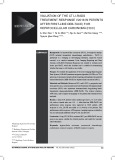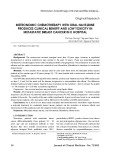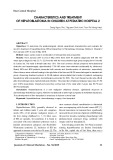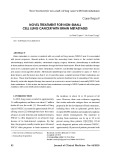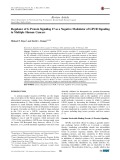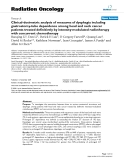
Including chemotherapy
-
In hepatocellular carcinoma (HCC), locoregional therapy (LRT) included transarterial chemotherapy embolization - TACE is performed as a bridging or downstaging treatment, improved overall survival, or a curative treatment.
 7p
7p  viling
viling
 11-10-2024
11-10-2024
 0
0
 0
0
 Download
Download
-
The metronomic concept emerged more than 20 year sago, however, a significant development in various solidtumors was noticed in the past 10 years. There are potentially several mechanisms of action against tumor cells including inhibition of angiogenesis. This study aims to assess the efficacy and the safety of ametronomic schedule of oral Vinorelbine (Navelbine) in treatment of metastatic breast cancer.
 6p
6p  vinatisu
vinatisu
 29-08-2024
29-08-2024
 1
1
 0
0
 Download
Download
-
To determine the epidemiological, clinical, paraclinical characteristics and evaluate the result in treatment of hepatoblastoma (HB) at Department of Hematology-Oncology, Children’s Hospital 2 from January 2011 to end of May 2019.
 5p
5p  vinatisu
vinatisu
 29-08-2024
29-08-2024
 3
3
 1
1
 Download
Download
-
Brain metastasis is common in patients with non-small cell lung cancer (NSCLC) and it is associated with poorer prognosis. Several options to control the secondary brain tumors in the context include chemotherapy, whole-brain radiation, stereotactic surgery, surgery. However, chemotherapy is ineffective to those patients because of poor penetration through the blood-brain barrier. Whole-brain radiation therapy used to be a standard option for brain metastases.
 5p
5p  vinatisu
vinatisu
 29-08-2024
29-08-2024
 4
4
 1
1
 Download
Download
-
No standard radiotherapy regimens have been established for the treatment of de novo metastatic nasopharyngeal carcinoma (mNPC) with bone-only metastasis. The current study aimed to investigate the efficacy of palliative chemotherapy (PCT) plus locoregional radiotherapy (LRRT) with or without local radiotherapy (RT) for metastatic bone lesions in mNPC.
 9p
9p  vielonmusk
vielonmusk
 21-01-2022
21-01-2022
 12
12
 0
0
 Download
Download
-
Regulators of G protein signaling (RGS) proteins modulate G protein-coupled receptor (GPCR) signaling networks by terminating signals produced by active Gα subunits. RGS17, a member of the RZ subfamily of RGS proteins, is typically only expressed in appreciable amounts in the human central nervous system, but previous works have shown that RGS17 expression is selectively upregulated in a number of malignancies, including lung, breast, prostate, and hepatocellular carcinoma.
 10p
10p  caothientrangnguyen
caothientrangnguyen
 09-05-2020
09-05-2020
 11
11
 0
0
 Download
Download
-
Tuyển tập các báo cáo nghiên cứu về y học được đăng trên tạp chí y học Radiation Oncology cung cấp cho các bạn kiến thức về ngành y đề tài: " Clinical-dosimetric analysis of measures of dysphagia including gastrostomy-tube dependence among head and neck cancer patients treated definitively by intensity-modulated radiotherapy with concurrent chemotherapy...
 10p
10p  toshiba10
toshiba10
 15-10-2011
15-10-2011
 49
49
 2
2
 Download
Download
-
Malaria, caused by four species of Plasmodium, of which Plasmodium falciparum is the most dangerous, remains the world's most devastating human parasitic infection. This chapter deals with the properties and uses of important drugs used to treat and prevent this infection. Highly effective agents that act against asexual erythrocytic stages of malarial parasites responsible for clinical attacks include chloroquine, quinine, quinidine, mefloquine, atovaquone, and the artemisinin compounds.
 362p
362p  vanass
vanass
 01-04-2011
01-04-2011
 80
80
 8
8
 Download
Download
-
Principles of Antibacterial Chemotherapy The choice of an antibacterial compound for a particular patient and a specific infection involves more than just a knowledge of the agent's pharmacokinetic profile and in vitro activity.
 9p
9p  colgate_colgate
colgate_colgate
 21-12-2010
21-12-2010
 82
82
 5
5
 Download
Download
-
Other Gram-Negative Bacteria Achromobacter xylosoxidans A. xylosoxidans (previously Alcaligenes xylosoxidans) is probably part of the endogenous intestinal flora and has been isolated from water sources. Immunocompromised hosts, including patients with cancer and post- chemotherapy neutropenia, cirrhosis, and chronic renal failure, are at increased risk. Nosocomial outbreaks of A. xylosoxidans infection have been attributed to contaminated fluids, and clinical illness has been associated with isolates from many sites, including blood (often in the setting of intravascular devices).
 5p
5p  colgate_colgate
colgate_colgate
 21-12-2010
21-12-2010
 83
83
 3
3
 Download
Download
-
Invasive Disease The treatment of a tumor that has invaded muscle can be separated into control of the primary tumor and, depending on the pathologic findings at surgery, systemic chemotherapy. Radical cystectomy is the standard, although in selected cases a bladder-sparing approach is used; this approach includes complete endoscopic resection; partial cystectomy; or a combination of resection, systemic chemotherapy, and external beam radiation therapy. In some countries, external beam radiation therapy is considered standard.
 5p
5p  konheokonmummim
konheokonmummim
 03-12-2010
03-12-2010
 61
61
 4
4
 Download
Download
-
Chemotherapy Unlike many other epithelial malignancies, breast cancer responds to multiple chemotherapeutic agents, including anthracyclines, alkylating agents, taxanes, and antimetabolites. Multiple combinations of these agents have been found to improve response rates somewhat, but they have had little effect on duration of response or survival. The choice among multidrug combinations frequently depends on whether adjuvant chemotherapy was administered and, if so, what type.
 5p
5p  konheokonmummim
konheokonmummim
 03-12-2010
03-12-2010
 69
69
 3
3
 Download
Download
-
One approach—so-called neoadjuvant chemotherapy—involves the administration of adjuvant therapy before definitive surgery and radiation therapy. Because the objective response rates of patients with breast cancer to systemic therapy in this setting exceed 75%, many patients will be "downstaged" and may become candidates for breast-conserving therapy. However, overall survival has not been improved using this approach.
 5p
5p  konheokonmummim
konheokonmummim
 03-12-2010
03-12-2010
 77
77
 4
4
 Download
Download
-
Chemoprevention β-Carotene and cis-retinoic acid can lead to the regression of leukoplakia. However, cis-retinoic acid does not reduce the incidence of second primaries Treatment Complications Complications from treatment of head and neck cancer are usually correlated to the extent of surgery and exposure of normal tissue structures to radiation. Currently, the extent of surgery has been limited or completely replaced by chemotherapy and radiation therapy as the primary approach. Acute complications of radiation include mucositis and dysphagia.
 5p
5p  konheokonmummim
konheokonmummim
 03-12-2010
03-12-2010
 86
86
 7
7
 Download
Download
-
Mucositis Irritation and inflammation of the mucous membranes particularly afflicting the oral and anal mucosa, but potentially involving the gastrointestinal tract, may accompany cytotoxic chemotherapy. Mucositis is due to damage to the proliferating cells at the base of the mucosal squamous epithelia or in the intestinal crypts. Topical therapies, including anesthetics and barrier-creating preparations, may provide symptomatic relief in mild cases.
 4p
4p  konheokonmummim
konheokonmummim
 03-12-2010
03-12-2010
 69
69
 4
4
 Download
Download
-
Principles of Chemotherapy Medical oncology is the subspecialty of internal medicine that cares for and designs treatment approaches to patients with cancer, in conjunction with surgical and radiation oncologists. The core skills of the medical oncologist include the use of drugs that may have a beneficial effect on the natural history of the patient's illness or favorably influence the patient's quality of life. In general, the curability of a tumor is inversely related to tumor volume and directly related to drug dose.
 9p
9p  konheokonmummim
konheokonmummim
 03-12-2010
03-12-2010
 93
93
 5
5
 Download
Download
-
Figure 80-1 Induction of p53 by the DNA damage and oncogene checkpoints. In response to noxious stimuli, p53 and mdm2 are phosphorylated by the ataxia telangiectasia mutated (ATM) and related ATR serine/threonine kinases, as well as the immediated downstream checkpoint kinases, Chk1 and Chk2. This causes dissociation of p53 from mdm2, leading to increased p53 protein levels and transcription of genes leading to cell cycle arrest (p21Cip1/Waf1) or apoptosis (e.g., the proapoptotic Bcl-2 family members Noxa and Puma).
 5p
5p  konheokonmummim
konheokonmummim
 03-12-2010
03-12-2010
 75
75
 6
6
 Download
Download
CHỦ ĐỀ BẠN MUỐN TÌM








